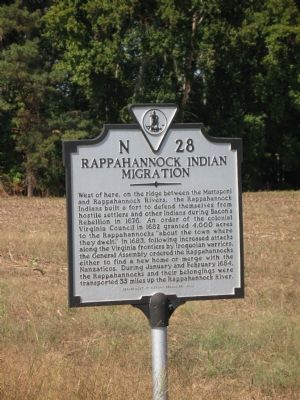Near Caret in Essex County, Virginia — The American South (Mid-Atlantic)
Rappahannock Indian Migration
Erected 2000 by Department of Historic Resources. (Marker Number N-28.)
Topics and series. This historical marker is listed in this topic list: Native Americans. In addition, it is included in the Virginia Department of Historic Resources (DHR) series list. A significant historical month for this entry is February 1684.
Location. 37° 57.568′ N, 76° 54.196′ W. Marker is near Caret, Virginia, in Essex County. Marker is on Historyland Highway (U.S. 17) north of Gwynnfield Road (County Route 703), on the right when traveling north. Touch for map. Marker is in this post office area: Tappahannock VA 22560, United States of America. Touch for directions.
Other nearby markers. At least 8 other markers are within 3 miles of this marker, measured as the crow flies. Bountiful Marshes (approx. 1.1 miles away); Gouldborough Plantation (approx. 1Ĺ miles away); Rivers of Grass (approx. 1Ĺ miles away); National Wildlife System (approx. 1.6 miles away); Pollinators (approx. 1.6 miles away); Hutchinson Tract (approx. 1.6 miles away); Toppahanock Indian Village (approx. 2.1 miles away); William Moore Tidewater Musician (approx. 3 miles away).
Also see . . . On the Road in Essex County - N-28 Rappahannock Indian Migration. 2020 article by Zorine Shirley in the River Country News. Excerpt:$
The indigenous people of our region, most likely had their first encounter with English explorers, in 1603. Captain Samuel Mace sailed up the Rappahannock River, brutally set upon the Rappahannock tribe, killed their chief and took a number of tribesmen back to England. Interestingly, it was later documented that these same men taught Englishmen how to make a dugout on the banks of the Thames River in London.(Submitted on September 17, 2020.)
Some accounts reveal that four years later, in 1607, Captain John Smith was captured by Powhatan tribesmen. Chief Opechancanough took him upriver to the town of “Topahanocke” for the Rappahannock to establish if this was the Englishman who had killed the chief and kidnapped their men. Smith was not the offender and was freed. Eventually, he mapped the tribal lands on the banks of the river
Credits. This page was last revised on September 17, 2020. It was originally submitted on October 21, 2007, by Laura Troy of Burke, Virginia. This page has been viewed 1,823 times since then and 44 times this year. Photo 1. submitted on October 21, 2007, by Laura Troy of Burke, Virginia. • J. J. Prats was the editor who published this page.
